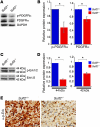Heparan sulfate sulfatase SULF2 regulates PDGFRα signaling and growth in human and mouse malignant glioma
- PMID: 22293178
- PMCID: PMC3287216
- DOI: 10.1172/JCI58215
Heparan sulfate sulfatase SULF2 regulates PDGFRα signaling and growth in human and mouse malignant glioma
Abstract
Glioblastoma (GBM), a uniformly lethal brain cancer, is characterized by diffuse invasion and abnormal activation of multiple receptor tyrosine kinase (RTK) signaling pathways, presenting a major challenge to effective therapy. The activation of many RTK pathways is regulated by extracellular heparan sulfate proteoglycans (HSPG), suggesting these molecules may be effective targets in the tumor microenvironment. In this study, we demonstrated that the extracellular sulfatase, SULF2, an enzyme that regulates multiple HSPG-dependent RTK signaling pathways, was expressed in primary human GBM tumors and cell lines. Knockdown of SULF2 in human GBM cell lines and generation of gliomas from Sulf2(-/-) tumorigenic neurospheres resulted in decreased growth in vivo in mice. We found a striking SULF2 dependence in activity of PDGFRα, a major signaling pathway in GBM. Ablation of SULF2 resulted in decreased PDGFRα phosphorylation and decreased downstream MAPK signaling activity. Interestingly, in a survey of SULF2 levels in different subtypes of GBM, the proneural subtype, characterized by aberrations in PDGFRα, demonstrated the strongest SULF2 expression. Therefore, in addition to its potential as an upstream target for therapy of GBM, SULF2 may help identify a subset of GBMs that are more dependent on exogenous growth factor-mediated signaling. Our results suggest the bioavailability of growth factors from the microenvironment is a significant contributor to tumor growth in a major subset of human GBM.
Figures









Similar articles
-
Measuring Sulfatase Expression and Invasion in Glioblastoma.Methods Mol Biol. 2022;2303:415-425. doi: 10.1007/978-1-0716-1398-6_33. Methods Mol Biol. 2022. PMID: 34626397
-
Sulfatase 2 up-regulates glypican 3, promotes fibroblast growth factor signaling, and decreases survival in hepatocellular carcinoma.Hepatology. 2008 Apr;47(4):1211-22. doi: 10.1002/hep.22202. Hepatology. 2008. PMID: 18318435 Free PMC article.
-
Secreted sulfatases Sulf1 and Sulf2 have overlapping yet essential roles in mouse neonatal survival.PLoS One. 2007 Jun 27;2(6):e575. doi: 10.1371/journal.pone.0000575. PLoS One. 2007. PMID: 17593974 Free PMC article.
-
Heparin-degrading sulfatases in hepatocellular carcinoma: roles in pathogenesis and therapy targets.Future Oncol. 2008 Dec;4(6):803-14. doi: 10.2217/14796694.4.6.803. Future Oncol. 2008. PMID: 19086847 Free PMC article. Review.
-
Platelet-derived growth factor receptor alpha in glioma: a bad seed.Chin J Cancer. 2011 Sep;30(9):590-602. doi: 10.5732/cjc.011.10236. Chin J Cancer. 2011. PMID: 21880180 Free PMC article. Review.
Cited by
-
Proteoglycans and their roles in brain cancer.FEBS J. 2013 May;280(10):2399-417. doi: 10.1111/febs.12109. Epub 2013 Feb 6. FEBS J. 2013. PMID: 23281850 Free PMC article. Review.
-
Glycosylation alterations in lung and brain cancer.Adv Cancer Res. 2015;126:305-44. doi: 10.1016/bs.acr.2014.11.007. Epub 2015 Feb 7. Adv Cancer Res. 2015. PMID: 25727152 Free PMC article. Review.
-
Cancer Metastasis: The Role of the Extracellular Matrix and the Heparan Sulfate Proteoglycan Perlecan.Front Oncol. 2020 Jan 17;9:1482. doi: 10.3389/fonc.2019.01482. eCollection 2019. Front Oncol. 2020. PMID: 32010611 Free PMC article. Review.
-
Glioma cell proliferation controlled by ERK activity-dependent surface expression of PDGFRA.PLoS One. 2014 Jan 29;9(1):e87281. doi: 10.1371/journal.pone.0087281. eCollection 2014. PLoS One. 2014. PMID: 24489888 Free PMC article.
-
SULF2 Expression Is a Potential Diagnostic and Prognostic Marker in Lung Cancer.PLoS One. 2016 Feb 16;11(2):e0148911. doi: 10.1371/journal.pone.0148911. eCollection 2016. PLoS One. 2016. PMID: 26882224 Free PMC article.
References
Publication types
MeSH terms
Substances
Grants and funding
LinkOut - more resources
Full Text Sources
Other Literature Sources
Medical
Molecular Biology Databases

